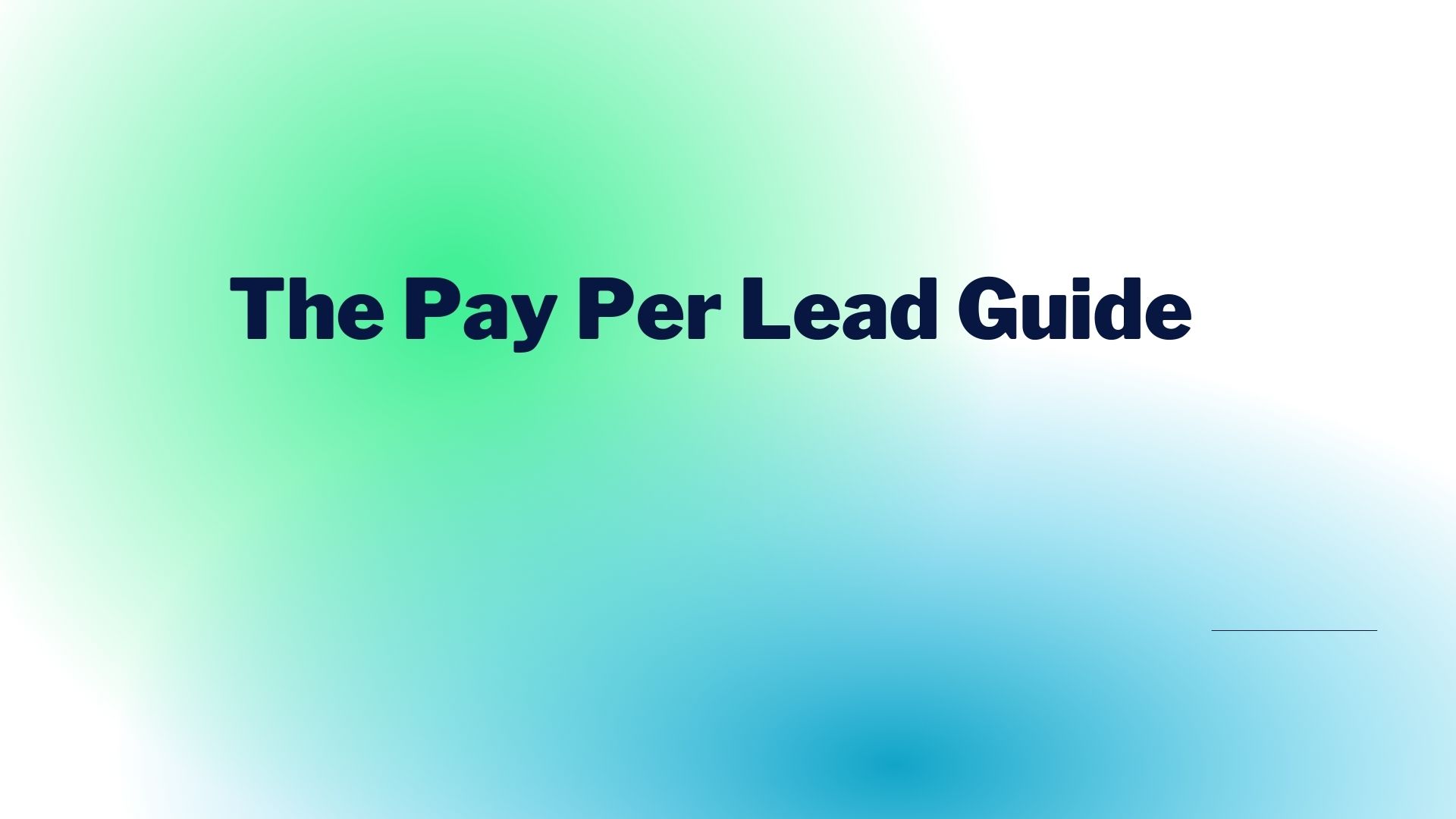Are you struggling to generate quality leads and considering a pay per lead model? Many brands find it challenging to attract qualified leads without investing too much time and money. The pay per lead model can help you make the most of your resources and receive qualified leads. By relying on an experienced pay per lead agency, you can save time and only pay for results. Keep reading to learn more about the pay per lead marketing model.
What is Pay Per Lead Marketing?
Customers are bombarded with advertisements and marketing messages all day, every day. It has becoming increasingly difficult for brands to attract the attention of their audience and hold their attention long enough to convey a clear message. These challenges can make it almost impossible to receive quality leads that can be converted into new clients.
Many businesses rely on social media ads or paid ad campaigns to attract new leads and find customers. Unfortunately, many businesses are wasting a lot of money on these ads without getting any traction. There are many reasons paid ad campaigns fail, including poor structure, unclear messaging, lack of followers, and low budgets.
Companies can also run into trouble if their audience is difficult to target. Some markets do not lend themselves to quality leads in abundance, and businesses can spin their wheels without getting anywhere. In fact, these businesses can waste money and receive poor quality leads that fall flat.
For all these reasons, and several others, some businesses are relying on pay per lead marketing. This form of marketing differs from pay per click ads because poor quality leads are sifted out. Companies only pay for quality leads they receive, regardless of how many clicks or impressions an ad receives.
Pay per lead marketing can help businesses better target their audience and maximize their marketing budget. Instead of paying for clicks or impressions, businesses pay for acquisitions of leads, including forms, sales, and subscriptions.
Pros and Cons of Pay Per Lead Marketing
| PROS | CONS |
| Brands only have to pay for leads that are generated, offering more control over spending and conversion costs. | Leads generated may be owned by the lead generation company, not the brand. |
| Pay per lead companies are incentivized to be more effective because they are paid based on performance. | Other companies may have access to the leads generated by the pay per lead agency. |
| Pay per lead is not widely used and can help set a brand apart from the competition. | Available leads may be split between multiple brands, causing a company to miss out on potential leads. |
| Less money is spent on advertising because qualified leads are delivered by the pay per lead company. | Brands do not have control over which leads are sent. They can only choose whether or not to work the leads they receive. |
| There is little work on the brand’s side in order to generate leads. | Brands do not own the assets or content used to generate leads. |
What is a lead?
Leads are essential for any business that makes a sale. However, different businesses define a “lead” in different ways. For some companies, a lead can refer to anyone that is interested in the business or their offerings. For other companies, a lead must be qualified by sales or marketing as legitimate. Other companies may place specific criteria on leads that are relevant to their business and sales goals. And sometimes leads are simply contact info like you’d find from one of the many ZoomInfo competitors, Hunter.io alternatives or millions of leads in the Apollo.io.
It is important to note that not all leads are created equal. It is possible to get both good and bad leads, and businesses will pay for both. Bad leads can include spam accounts, competitors searching for information, or people who are not actually looking to buy. Bad leads can also include potential customers who are not far along enough in the buying cycle to make a decision.
Good leads, on the other hand, have a higher probability of converting into a sale or customer. Good leads include people who are in the right place in their buying journey, those looking to make a decision soon, people recommended by another customer, or leads generated by sales and marketing. Ideally, as a brand you have qualifying criteria you use when determining a lead.
Why are leads important?
Every business has an ideal customer persona. This persona includes the demographics and traits of their ideal customer and the audience they are targeting. A buyer persona helps brands narrow their focus and efforts to people who are most likely to convert and become customers. The buyer persona can also help brands identify the best channels to reach their audience and craft the most effective messages.
The ideal customer for a women’s clothing boutique is not going to be the same as the ideal customer for an auto parts shop. While some businesses may have overlapping characteristics in their buyer persona, their full buyer personas will differ in many areas. With a comprehensive and clear buyer persona in place, companies can target leads for their business.
Leads are essential for businesses that sell products or services. Attracting leads helps a business raise awareness for their brand and offerings. Ultimately, the goal is to convert leads into paying customers and repeat business. Without quality leads, a business cannot build a solid customer base.
How do businesses get leads?
Lead generation is the process of bringing in new leads, or potential customers, for your business. The goal is to increase interest in your brand, nurture leads, and convert leads into customers. The lead generation process can look different across companies and industries, but the end goal remains the same. Businesses want to target their ideal customer or audience and turn them into paying customers.
There are many ways that businesses can generate leads, including pay per lead marketing. Common lead generation strategies include:
- Content: Blogs, eBooks, guides, ads, and other content that is useful for the audience and provides free information. Content for lead generation includes a call to action, encouraging the visitor to interact more with the brand.
- Emails: Many businesses rely on email communications to grab someone’s attention and deliver a clear message. Some businesses purchase email lists while others create their own email lists from scratch.
- Paid ads: There are many options when it comes to paid ads, including pay per click and pay per lead marketing. Ads can be created for a target audience and delivered through specific channels.
- Social media: Many brands rely on social media platforms to attract new leads, including their brand pages and paid social media ads.
- Referrals: Word of mouth is one of the most effective marketing strategies. Businesses can generate leads by collecting referrals from existing customers.
- Cold Calling: teams of cold callers can do regular outreach via the phone to connect with prospects and try to convert them into a lead.
There is always a temptation to buy leads in order to fill the sales funnel. While it is faster to buy leads from an off the shelf lead list than it is to organically generate leads, buying leads does not always produce quality results. Buying leads can get you blacklisted as spam, damage your reputation, and ultimately waste your time and money by producing poor quality leads.
However, working with a credible partner who you pay to generate leads is a different story. When selecting a pay per lead partner, this can be an effective approach to acquiring leads. Some businesses can’t afford to produce leads in house and need to rely on an outside agency for help.
How does pay per lead marketing work?
Pay per lead marketing is a program that is based on performance. A brand works with a pay per lead company to generate quality leads. Leads are based on an action that is agreed upon by both the brand and the lead generation company. Actions can include form submissions, sales, subscriptions, and more. The brand only pays the lead generation company when leads are delivered.
The advertiser or lead generation company is responsible for bringing leads to the brand. If they are successful, they receive a commission per lead. Pay per lead marketing differs from pay per click or pay per impression marketing because leads are more interested in a product or service and more engaged. Too often, people click on an ad or content without intending to buy a product or pay for a service. Pay per lead marketing weeds out the extra costs associated with pay per click marketing.
What Types of Companies are Good for Pay Per Lead Services?
Pay per lead marketing companies are not as common as pay per click services. However, you can still find plenty of agencies or advertisers willing to offer a pay per lead model. Brands have the option of working with a large advertiser, a boutique lead generation agency, or a local company that specializes in pay per lead marketing.
Pay per lead marketing can be a complex process and brands should seek out qualified agencies with experience in pay per lead marketing and measurable success. When searching for a pay per lead provider, it is important to ask for projections and set clear goals. Budget and time constraints can also factor into the decision of which company to use for pay per lead services.
There are many large scale, national pay per lead providers. You can usually expect to pay more for these companies’ services, but they typically deliver favorable results.
For some brands, a large provider may not be the best option. If your target audience is located in one specific area or industry, it may be best to work with a pay per lead company that meets those unique needs.
What to Look for in Pay Per Lead Companies
There are many things to consider when hiring an advertiser for pay per lead services. Each brand will have unique needs and goals when it comes to generating quality leads, and there is not a one-size-fits-all solution. The best pay per lead provider will depend on a brand’s budget, audience, and goals.
Consider the following questions when searching for a pay per lead service provider.
- What is your overall budget? Based on the pay per lead agency’s cost per lead, how many leads can you afford?
- What is your target lead generation goal? How many leads do you need to generate to reach your sales goals?
- Who is your ideal customer? Who is your target audience? Can the lead generation company reach those people?
- How much experience does the pay per lead company have? Can they provide concrete examples of past programs and their success rates?
- Do you have to share leads with other companies? Are leads split between the agency’s clients?
- Will you own the leads that are generated? Will the agency retain ownership of the leads?
- Can you access or use the content created to generate leads? Are the assets used for lead generation exclusive to the agency?
- Is the company located locally or overseas? Either option is fine, but this could impact your timeline and communication.
- Is this an outbound lead generation company or do they focus solely on inbound lead generation?
These questions can help you determine which pay per lead agency best aligns with your goals. It is important to have your budget and goals clearly defined before meeting with agencies. This will help you narrow down your options faster and avoid overspending.
Pay Per Lead Model
The exact model for pay per lead services will differ by provider, but the general outline should be the same across the board. Once you choose a pay per lead agency, you can begin the process of generating leads.
- Define your budget and goals: The agency will request a budget as well as how many leads you are hoping to generate.
- Define your “qualified” lead: You will let the agency know what you consider to be a qualified lead. Leads must complete an action agreed upon by both the agency and your brand, which can include submitting a form, making a call, making a purchase, or subscribing to your newsletter. Choose the best action that will help you determine which leads are highly qualified.
- Define your target audience: You should provide the agency with your buyer persona so they can focus on your target audience. The more clearly you can define your target audience, the more focused the agency can be when generating leads.
- Define your channels or platforms: Together with the agency you can determine which channels or platforms work best for your brand and audience. Pay per lead services can fall into a variety of advertising categories, including display ads, search engine marketing, social media, retargeting, and video ads.
- Let the agency get to work: Once all criteria are defined, the agency can get to work creating assets to generate leads.
- Receive leads in your CRM: The agency should work with you to deliver all qualified leads to your CRM. This can be done automatically through integrations or manually through regular lead reports.
- Pay for your leads: With the pay per lead model, you do not pay for the agency’s time or efforts creating assets. Instead, you only pay for the leads you receive.
- Evaluate your program: It is wise to periodically evaluate your pay per lead program to ensure you are receiving leads that meet your needs and help you reach your goals.
Pay Per Lead Services and Deliverables
Pay per lead services can deliver a variety of lead types. It is important to decide which type of leads you need before meeting with a pay per lead agency.
- Marketing Qualified Leads (MQLs): These leads meet the criteria of your buyer persona and fit within your target audience. They are typically aware that they need a solution and are becoming aware of your product.
- Sales Qualified Leads (SQLs): These leads are very promising and highly likely to convert. If you are able to provide value and stand out from the competition, your sales team can negotiate a deal.
- Appointment Setting: These leads are willing to meet with your sales team to learn more about your products or services. They are aware of your products and services.
How are Pay Per Leads Generated?
Pay per lead agencies use a variety of methods to generate leads. You can designate specific channels for lead generation, or you can trust the knowledge and experience of the agency to choose the best method.
- Cold calling: Someone calls potential leads from a list, gauging their interest in your solution.
- Cold emailing: Someone emails potential leads from a list, telling them more about your products and solutions.
- Digital marketing: Leads are attracted to your brand through online content, including digital ads, social media, blogs, video ads, and more.



